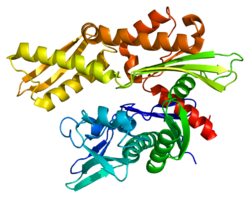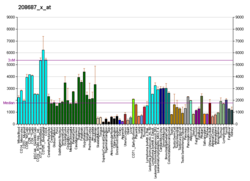1atr: THREONINE 204 OF THE CHAPERONE PROTEIN HSC70 INFLUENCES THE STRUCTURE OF THE ACTIVE SITE BUT IS NOT ESSENTIAL FOR ATP HYDROLYSIS
1ats: THREONINE 204 OF THE CHAPERONE PROTEIN HSC70 INFLUENCES THE STRUCTURE OF THE ACTIVE SITE BUT IS NOT ESSENTIAL FOR ATP HYDROLYSIS
1ba0: HEAT-SHOCK COGNATE 70KD PROTEIN 44KD ATPASE N-TERMINAL 1NGE 3
1ba1: HEAT-SHOCK COGNATE 70KD PROTEIN 44KD ATPASE N-TERMINAL MUTANT WITH CYS 17 REPLACED BY LYS
1bup: T13S MUTANT OF BOVINE 70 KILODALTON HEAT SHOCK PROTEIN
1ckr: HIGH RESOLUTION SOLUTION STRUCTURE OF THE HEAT SHOCK COGNATE-70 KD SUBSTRATE BINDING DOMAIN OBTAINED BY MULTIDIMENSIONAL NMR TECHNIQUES
1hpm: HOW POTASSIUM AFFECTS THE ACTIVITY OF THE MOLECULAR CHAPERONE HSC70. II. POTASSIUM BINDS SPECIFICALLY IN THE ATPASE ACTIVE SITE
1hx1: CRYSTAL STRUCTURE OF A BAG DOMAIN IN COMPLEX WITH THE HSC70 ATPASE DOMAIN
1kax: 70KD HEAT SHOCK COGNATE PROTEIN ATPASE DOMAIN, K71M MUTANT
1kay: 70KD HEAT SHOCK COGNATE PROTEIN ATPASE DOMAIN, K71A MUTANT
1kaz: 70KD HEAT SHOCK COGNATE PROTEIN ATPASE DOMAIN, K71E MUTANT
1nga: STRUCTURAL BASIS OF THE 70-KILODALTON HEAT SHOCK COGNATE PROTEIN ATP HYDROLYTIC ACTIVITY, II. STRUCTURE OF THE ACTIVE SITE WITH ADP OR ATP BOUND TO WILD TYPE AND MUTANT ATPASE FRAGMENT
1ngb: STRUCTURAL BASIS OF THE 70-KILODALTON HEAT SHOCK COGNATE PROTEIN ATP HYDROLYTIC ACTIVITY, II. STRUCTURE OF THE ACTIVE SITE WITH ADP OR ATP BOUND TO WILD TYPE AND MUTANT ATPASE FRAGMENT
1ngc: STRUCTURAL BASIS OF THE 70-KILODALTON HEAT SHOCK COGNATE PROTEIN ATP HYDROLYTIC ACTIVITY, II. STRUCTURE OF THE ACTIVE SITE WITH ADP OR ATP BOUND TO WILD TYPE AND MUTANT ATPASE FRAGMENT
1ngd: STRUCTURAL BASIS OF THE 70-KILODALTON HEAT SHOCK COGNATE PROTEIN ATP HYDROLYTIC ACTIVITY, II. STRUCTURE OF THE ACTIVE SITE WITH ADP OR ATP BOUND TO WILD TYPE AND MUTANT ATPASE FRAGMENT
1nge: STRUCTURAL BASIS OF THE 70-KILODALTON HEAT SHOCK COGNATE PROTEIN ATP HYDROLYTIC ACTIVITY, II. STRUCTURE OF THE ACTIVE SITE WITH ADP OR ATP BOUND TO WILD TYPE AND MUTANT ATPASE FRAGMENT
1ngf: STRUCTURAL BASIS OF THE 70-KILODALTON HEAT SHOCK COGNATE PROTEIN ATP HYDROLYTIC ACTIVITY, II. STRUCTURE OF THE ACTIVE SITE WITH ADP OR ATP BOUND TO WILD TYPE AND MUTANT ATPASE FRAGMENT
1ngg: STRUCTURAL BASIS OF THE 70-KILODALTON HEAT SHOCK COGNATE PROTEIN ATP HYDROLYTIC ACTIVITY, II. STRUCTURE OF THE ACTIVE SITE WITH ADP OR ATP BOUND TO WILD TYPE AND MUTANT ATPASE FRAGMENT
1ngh: STRUCTURAL BASIS OF THE 70-KILODALTON HEAT SHOCK COGNATE PROTEIN ATP HYDROLYTIC ACTIVITY, II. STRUCTURE OF THE ACTIVE SITE WITH ADP OR ATP BOUND TO WILD TYPE AND MUTANT ATPASE FRAGMENT
1ngi: STRUCTURAL BASIS OF THE 70-KILODALTON HEAT SHOCK COGNATE PROTEIN ATP HYDROLYTIC ACTIVITY, II. STRUCTURE OF THE ACTIVE SITE WITH ADP OR ATP BOUND TO WILD TYPE AND MUTANT ATPASE FRAGMENT
1ngj: STRUCTURAL BASIS OF THE 70-KILODALTON HEAT SHOCK COGNATE PROTEIN ATP HYDROLYTIC ACTIVITY, II. STRUCTURE OF THE ACTIVE SITE WITH ADP OR ATP BOUND TO WILD TYPE AND MUTANT ATPASE FRAGMENT
1qqm: D199S MUTANT OF BOVINE 70 KILODALTON HEAT SHOCK PROTEIN
1qqn: D206S MUTANT OF BOVINE 70 KILODALTON HEAT SHOCK PROTEIN
1qqo: E175S MUTANT OF BOVINE 70 KILODALTON HEAT SHOCK PROTEIN
1ud0: CRYSTAL STRUCTURE OF THE C-TERMINAL 10-kDA SUBDOMAIN OF HSC70
1yuw: crystal structure of bovine hsc70(aa1-554)E213A/D214A mutant
2bup: T13G MUTANT OF THE ATPASE FRAGMENT OF BOVINE HSC70
3hsc: THREE-DIMENSIONAL STRUCTURE OF THE ATPASE FRAGMENT OF A 70K HEAT-SHOCK COGNATE PROTEIN
7hsc: HIGH RESOLUTION SOLUTION STRUCTURE OF THE HEAT SHOCK COGNATE-70 KD SUBSTRATE BINDING DOMAIN OBTAINED BY MULTIDIMENSIONAL NMR TECHNIQUES




































